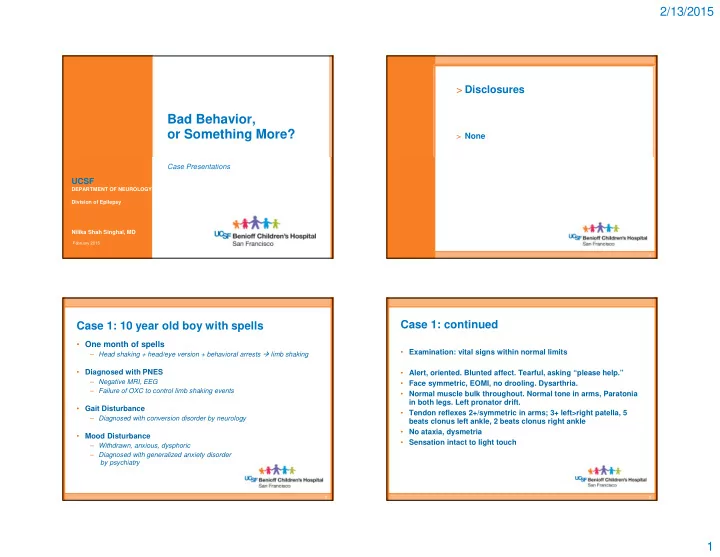

2/13/2015 > Disclosures Bad Behavior, or Something More? > None Case Presentations UCSF DEPARTMENT OF NEUROLOGY Division of Epilepsy Nilika Shah Singhal, MD February 2015 3 Case 1: continued Case 1: 10 year old boy with spells • One month of spells • Examination: vital signs within normal limits – Head shaking + head/eye version + behavioral arrests � limb shaking • Diagnosed with PNES • Alert, oriented. Blunted affect. Tearful, asking “please help.” – Negative MRI, EEG • Face symmetric, EOMI, no drooling. Dysarthria. – Failure of OXC to control limb shaking events • Normal muscle bulk throughout. Normal tone in arms, Paratonia in both legs. Left pronator drift. • Gait Disturbance • Tendon reflexes 2+/symmetric in arms; 3+ left>right patella, 5 – Diagnosed with conversion disorder by neurology beats clonus left ankle, 2 beats clonus right ankle • No ataxia, dysmetria • Mood Disturbance • Sensation intact to light touch – Withdrawn, anxious, dysphoric – Diagnosed with generalized anxiety disorder by psychiatry 2 2 1
2/13/2015 Case 1: continued Case 1: continued • Several typical spells seen during the evaluation: feeling of “ about to have one” � • Hypermotor legs • Erratic clonic jerking + tonic stiffening of left leg with left arm stiffening and right arm flexion . • Duration <30 seconds, no impaired awareness during the episode, no post-ictal state. 2 2 Case 1: Q1: How would you characterize this Case 1: continued event with bilateral motor symptoms but preserved awareness? A. Psychogenic non-epileptic seizure B. Supplementary Motor Area seizure 74% C. Movement Disorder (dyskinesia) D. Behavioral disturbance 13% 9% 4% e . . . . . . . n c i . s . t A y a p e r d b o ( r i l u p t r t o e e M d s - d i n r o y o l s a n r i r a D o c t i n t i n v e e n a m e g h o e m e B h p l e c v y p u o s M P S 2 2 2
2/13/2015 Case 1: Q2: What would you predict would Case 1: Diagnosis: Anti-NMDAr Encephalitis be the next diagnostic step? A. Another MRI • Psychiatric episodes can occur at presentation, in B. Blood tests to search for vasculitis isolation, in children C. Psychiatry referral for a frustrated – Delusional thinking, mood disturbances, aggression 53% patient and neurologist D. Lumbar puncture to search for 28% • A wide variety of movement disorders are seen in inflammation 18% children – Patients commonly present with more than one movement 1% disorder – Gait impairment, chorea, stereotypic movements, ataxia, I R . . . M . . . . . r r f a r o a e e h f s dystonia, limb monorhythmia, athetosis, tremor, o r o t h o c f t n r l e A a a r e r u s r e t o c blepharospasm e f n t r u s p t y s r e t r t a a b d h i m o c o y u s l L B P 2 2 Case 2: 5 year old boy with episodes of > Next case anxiety • Two weeks of spells – Sudden-onset crying, seeming anxious and fearful; makes eye contact with grandmother and reaches out for her – He may ‘thrash about’ seem generally tremulous. – Self-resolving in <30 seconds. – Afterwards, he resumes what he was doing. – Patient seems scared in even trying to describe his experience 3 2 3
2/13/2015 Case 2: Q1: What do you think is the next Case 2: continued most useful diagnostic test to perform? • Occurred from wakefulness initially; started to occur A. Brain MRI from sleep B. Lumbar Puncture 73% • Three hospital visits C. Extended video EEG monitoring – Toxicology screen, head CT, EEG obtained D. Serum tests for metabolic diseases • Diagnosed with psychosis; placed on a psychiatric hold 16% 7% 5% – Received Risperdal, Benadryl, Valium I R e . . M r . . u . c . n t i n c o o l i n m a b u r a B P G t r E e a E m b o m r e o u d f L i s v t d s e e d t n m e u t r x e E S 2 2 Case 2 2 3 4
2/13/2015 Case 2: Further work-up Case 2: Features of cingulate gyrus seizures • Hypermotor • Ictal Vocalization • Infrequent generalization • Presence of emotionality: fear, laughter • Presence of personality changes 2 2 Case 2: Q2: What are advantages of epilepsy surgery compared to medical management of medically-refractory focal cortical dysplasia? A. Improved life expectancy 68% B. Seizure-free rates higher than medical management C. Improved IQ D. Answers 1 and 2 21% 10% E. All of the above 0% 0% 2 y Q e c . I n . . d v r d n o a e e b t a c h v a e g o 1 i e p h r s h x p r t e s m e e w f I o e t s f a n l i r l l A A d e e e r v f o - e r r p u m z I i e S 2 3 5
2/13/2015 > Thank you! Referring and Provider consultation, Access Center: Phone: (855)-PBC-UCSF 2 3 6
Recommend
More recommend